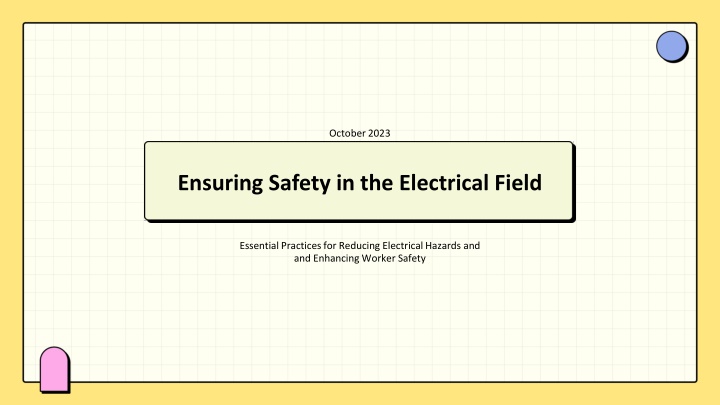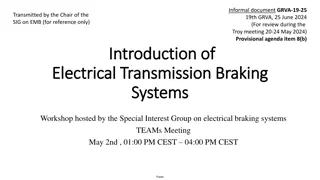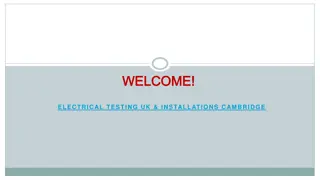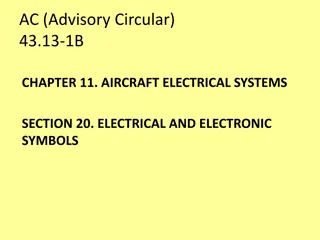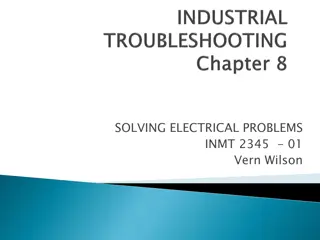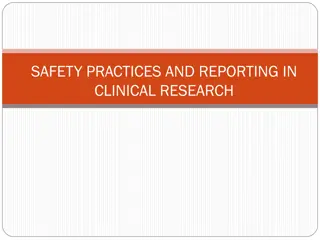Enhancing Electrical Safety Practices
Learn essential practices for reducing electrical hazards and enhancing worker safety in the electrical field. Topics include proper equipment connection, common electrical hazards, essential PPE, and emergency protocols.
Download Presentation

Please find below an Image/Link to download the presentation.
The content on the website is provided AS IS for your information and personal use only. It may not be sold, licensed, or shared on other websites without obtaining consent from the author.If you encounter any issues during the download, it is possible that the publisher has removed the file from their server.
You are allowed to download the files provided on this website for personal or commercial use, subject to the condition that they are used lawfully. All files are the property of their respective owners.
The content on the website is provided AS IS for your information and personal use only. It may not be sold, licensed, or shared on other websites without obtaining consent from the author.
E N D
Presentation Transcript
October 2023 Ensuring Safety in the Electrical Field Essential Practices for Reducing Electrical Hazards and and Enhancing Worker Safety
Table of Contents 5 Extension Cords Explained 1 Electrical Safety 101 Importance of Proper Equipment Connection 6 Stay Safe: Common Electrical Hazards 2 Grounding Electrical Equipment 7 Essential PPE for Electrical Safety 3 Keeping the Current Flowing 8 Electrical Incident Safety 4
Empowering Safety: Training Employees on Electrical Protocols 9 Learning from the Past: Electrical Safety Case Studies 10 11 Electrical Safety Essentials Conclusion: Commitment to Safety in Electrical Work 12
Electrical Safety 101 1.Safety First 2.Know the Risks Understanding electrical safety is crucial for preventing accidents. Always assess the risks before using electrical equipment. Proper training can minimize hazards and ensure a safe... Identify potential electrical hazards in the workplace, such as exposed exposed wires, overloaded circuits, and faulty equipment. Conduct Conduct regular inspections and encourage employees to report any... report any... 3.Protect Yourself 4.Emergency Protocols Implement safety measures such as wearing insulated gloves, using using ground fault circuit interrupters (GFCIs), and ensuring devices devices are properly maintained. Create a culture of safety... Establish clear emergency protocols for electrical accidents, including including shut-off procedures, evacuation routes, and first- aid responses. Regular drills can prepare employees for unexpected unexpected situations. aid
Importance of Proper Equipment Connection Benefits of Correct Connections Risks of Improper Connections Proper equipment connections enhance safety by preventing electrical shocks and fires that can occur due to faulty wiring. Improper connections can lead to short circuits, causing not only not only equipment damage but also potential hazards to to individuals nearby. Correct connections ensure efficient energy flow, reducing energy waste and lowering utility costs for users. Neglecting proper connections may result in electrical fires, which can cause substantial property damage and loss of life. Adhering to connection protocols fosters compliance with regulations, protecting individuals and businesses from legal liabilities. Incorrect connections often lead to equipment malfunctions, leading to increased maintenance costs and operational downtime.
Grounding Electrical Equipment 99% Electrical Safety 90% Shock Prevention 80% Equipment Protection 70% Risk Reduction
Keeping the Current Flowing 2023 2023 2023 2023 Preventing Breakdowns Extending Equipment Life Compliance and Safety Regular Inspections Routine maintenance checks are crucial for ensuring electrical equipment operates efficiently. Regular inspections help identify potential issues before they escalate, preventing costly repairs and downtime. Conducting timely maintenance maintenance checks reduces the the risk of unexpected equipment equipment failures. By being proactive, organizations can maintain productivity and ensure ensure safety in the workplace. Regular inspections not only enhance safety but also extend the extend the lifespan of electrical electrical equipment. Consistent Consistent maintenance contributes to optimal performance and reliability over over time. Routine maintenance checks ensure compliance with safety regulations. Regular inspections inspections protect not just the the equipment, but also the safety safety of personnel, minimizing the minimizing the risk of electrical electrical hazards.
Extension Cords Explained 1.Temporary Use Only 2.Safety Risks Extension cords are intended for temporary use during specific tasks. Prolonged usage can lead to overheating and increased risk of electrical fires. Using extension cords improperly increases safety risks, including tripping hazards and electrical shock. Understanding these risks is vital for safe home and workplace environments. 3.Proper Guidelines 4.Common Misuse Follow proper guidelines for extension cord use: understand amp ratings, avoid daisy-chaining, and regularly inspect cords for wear and damage to ensure safety. Common misuses include using cords as permanent wiring, overloading circuits, and hiding cords under carpets. Addressing these Addressing these issues can prevent dangerous situations.
Stay Safe: Common Electrical Hazards 1. Electrical shocks can occur due to faulty wiring or damaged equipment. Always inspect and maintain electrical electrical systems to prevent potential accidents and injuries. 2. Overloaded circuits are a common hazard. Plugging too many devices into a single outlet can cause overheating and lead to fire risks always distribute your electrical load properly. 3. Wet conditions significantly increase the risk of electrical hazards. Ensure all electrical devices and outlets are kept dry to prevent shocks or short circuits, especially in outdoor or humid areas. 4. Neglecting to use appropriate personal protective equipment (PPE) can expose workers to serious risks. Always wear insulated gloves and safety glasses when handling electrical tools or equipment.
Essential PPE for Electrical Safety 90% Head Protection 85% Eye Protection 95% Hand Protection 80% Foot Protection
Electrical Incident Safety 1.Stay Calm First 2.Identify the Issue In any electrical emergency, remain calm to assess the situation. Panic can lead to rash decisions. Take a deep breath to think clearly about your... Determine the nature of the electrical issue. Is there a fire, an electrocution, or a short circuit? Identifying the problem clearly will clearly will help you react... 4.Follow Procedures 3.Call for Help Dial emergency services immediately if needed. Use a phone or or another safe method to alert professionals about the electrical electrical incident. Ensure they understand the situation... Adhere strictly to established emergency procedures. This includes includes shutting off power if safe to do so, avoiding contact with with water, and using fire extinguishers suitable...
Empowering Safety: Training Employees on Electrical Protocols 1. Training programs create awareness about electrical hazards, ensuring employees recognize dangers in the in the workplace. This knowledge enables proactive safety measures to prevent accidents. 2. Regular training updates help employees stay informed about new safety protocols, ensuring compliance with industry standards and regulations, ultimately leading to a safer work environment. 3. Practical training sessions allow employees to engage with electrical safety tools and techniques, enhancing their skills in a hands-on manner, which significantly improves retention and confidence. 4. Fostering a culture of safety through training leads to improved employee morale and productivity. When employees feel safe, they are more focused and engaged in their work.
Learning from the Past: Electrical Safety Case Studies 1. Understanding past electrical incidents helps identify common hazards and improve safety measures. These case studies underline the importance of proactive strategies to prevent future accidents. 2. Each case study illustrates unique situations where electrical safety protocols failed. Analyzing these failures provides insights into necessary changes in regulations and training for better safety outcomes. 3. The importance of ongoing education and training in electrical safety cannot be understated. Regular updates and refresher courses ensure that staff are aware of current best practices and safety protocols. Photo by Pexels 4. Collaboration between industry experts and regulatory agencies is vital. Sharing knowledge from past incidents enables the development of more effective safety measures and fosters a culture of safety within organizations.
Electrical Safety Essentials 1.Training Guidelines 2.Manuals Overview Explore comprehensive training guidelines that outline critical critical protocols for electrical safety. These guidelines ensure that all that all personnel can operate safely and prevent potential hazards hazards in... Discover various manuals available for electrical safety training, training, including in-depth procedures, safety checklists, and and emergency response actions. These manuals serve as essential essential references during training... 3.Available Resources 4.Best Practices Learn about the diverse resources available for enhancing electrical safety training. This includes online courses, workshops, and hands-on simulations that equip workers with necessary skills... Understand the best practices in electrical safety that should be be promoted within organizations. These practices include regular regular training updates, safety audits, and fostering a culture... culture...
Conclusion: Commitment to Safety in Electrical Work Benefits of Safety Practices Drawbacks of Neglecting Safety Implementing safety practices reduces the risk of accidents and injuries in electrical work environments. Neglecting safety practices increases the likelihood of serious serious accidents, resulting in injuries or fatalities. Safety protocols build a culture of responsibility, enhancing team morale and trust among workers. Ignoring safety protocols can lead to significant financial losses due to downtime or equipment damage. Regular training and adherence to safety measures can lead to long-term cost savings by avoiding fines and legal issues. Non-compliance with safety regulations could result in legal repercussions, including lawsuits and penalties.
